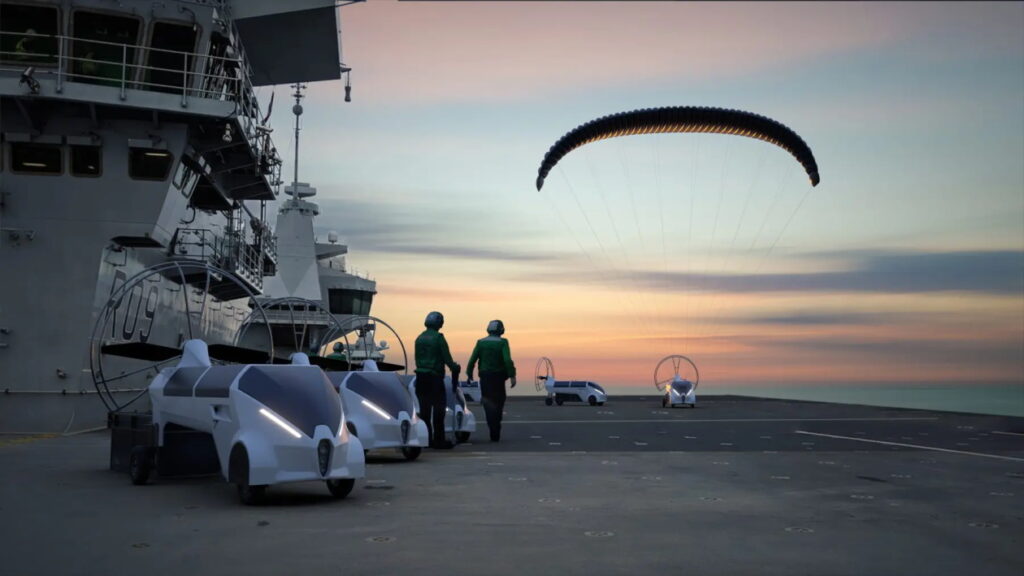



Animal Dynamics, a specialist developer of autonomous heavy-lift uncrewed aerial vehicles (UAVs), has confirmed that it has been selected to participate in the next phase of the Royal Navy’s Uncrewed Aerial Systems Heavy Lift Challenge (UASHLC) with its Stork STM parafoil UAV.
The Stork STM is an autonomous aerial logistics platform capable of beyond visual line of sight (BVLOS) operations and carrying payloads weighing 135kg over a 400km distance (the equivalent of flying from Oxford to Paris). This payload capacity has been chosen as it is an optimum weight to resupply an eight-person section for a two-day period.
UASHLC Phase 2 is a joint effort between Defence Equipment & Support’s (DE&S) Future Capability Group and the Royal Navy’s Office of the Chief Technology Officer and 700X Naval Air Squadron. It aims to explore potential use cases for uncrewed technologies to deliver supplies and equipment intra-theatre (ship-to-ship) and inter-theatre (ship-to-shore and vice versa), which would free up crewed assets like helicopters to perform more specialist tasks. The ability to carry a 135kg payload up to 400km makes Stork STM unique in meeting the Royal Navy’s requirements for both intra- and inter-theatre resupply tasks.
Animal Dynamics successfully demonstrated the Stork STM’s ability to carry significant payloads over a large distance as part of a pre-selection flying competition that took place last year. Despite strong competition from a number of world-class UAV providers, the Stork STM scored very highly and was awarded a coveted place on the UASHLC. The Stork STM will now continue to the next round of UASHLC testing, with flight trials planned to take place in Cornwall, UK.
As part of UASHLC, Animal Dynamics will also be marinising the Stork STM by integrating secure satellite communications (SATCOM) that enable the vehicle to be operated anywhere in the world. The Stork STM will also be fitted with a sonobuoy dispenser – showcasing that the UAV’s payload space can be used for a number of mission types – as well as go through additional wing development work that includes a retraction capability to make it safe for deck operations.
The Stork STM’s ground-breaking parafoil design overcomes many of the challenges associated with heavy-lift multirotor and hybrid VTOL designs, which are often range-limited due to the need for significant power during take-off and landing. Unlike traditional fixed-wing aircraft, the Stork STM can take-off and land in short distances on unprepared ground.
Adrian Thomas, CEO of Animal Dynamics, said: “We are very excited to have won a place in the UASHLC through our performance in the fly-offs against strong competition from established UAV and aerospace companies. Selection by the UK Ministry of Defence (MoD) and the Royal Navy reflects the fantastic capabilities the Stork STM has to offer, and the strength and experience of the team in terms of engineering, flight ops and certification. We look forward to the next stage of flight trials when we can demonstrate the continuing performance and capability enhancements of the Stork STM and the clear path to commercialisation.”
Chris Roberts, Head of Engineering Operations at Animal Dynamics, commented: “Our success in being selected for the next phase of the UASHLC has validated that our design concept can meet challenging customer requirements at a live demo. Our operations team relished the opportunity to conduct a live demo, during which the Stork STM performed fantastically, showing to the MoD the potential that our technology could play in naval resupply roles.”
Find suppliers & manufacturers of Heavy Lift Drones & UAS >>





Related Posts
New Drone Fires Thales Missile in Unmanned Air Combat Milestone
UAS Startup Accelerator Awards 3M in Funding
US Navy Orders Unmanned Tactical Resupply Aircraft